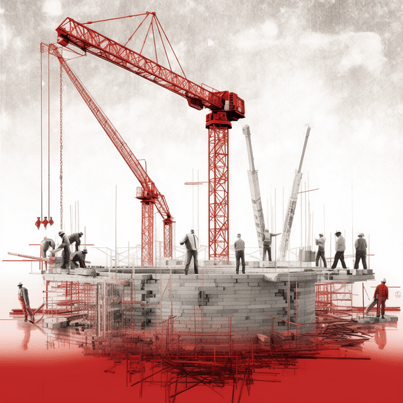Did you know that research and development (R&D) tax credits can significantly benefit your construction business, potentially saving you thousands of dollars in taxes? Understanding and taking advantage of these credits can be a game-changer for your company. Let’s delve into the world of R&D tax credits in the construction industry and learn how to unlock their potential.
Short Summary
- Engaging professional expertise can help construction companies maximize the financial benefits of R&D tax credits.
- Federal- and state-level R&D tax credits offer entrepreneurs a way to reduce their income tax liability based on qualified domestic expenses.
- Adequate documentation and compliance is essential for successful R&D tax credit claims.
Understanding R&D Tax Credits in the Construction Industry

R&D tax credits offer significant financial advantages for construction companies, such as federal- and state-level credits, that can be carried forward for up to two decades. These credits incentivize companies to invest in qualified research activities to improve their construction processes.
However, navigating the intricate and stringent regulations governing eligibility for R&D tax credits can be challenging. That’s why engaging the expertise of professionals, such as Acena Consulting, can help maximize your R&D tax credit benefits.
Federal- and State-Level Credits
Federal- and state-level R&D tax credits are incentives that allow companies to reduce their income tax liability based on qualified domestic expenses related to the design, development, or improvement of products, processes, techniques, formulas, or software. The federal R&D tax credit is a dollar-for-dollar reduction of a company’s tax bill, while each state has unique rates and qualifications for research and development tax credits. Currently, 35 U.S. states offer the R&D tax credit to entrepreneurs, allowing them to benefit from the incentive.
Approximately 40 states provide an R&D credit to offset state tax liability, serving to reduce the financial burden on construction companies investing in research and development activities. By understanding and utilizing both federal- and state-level R&D tax credits, construction companies can reap substantial tax savings and reinvest in their growth and innovation.
Carry Forward Rules

If your construction company is eligible for R&D tax credits but does not have any taxable income, the credits can be carried back one year and pushed forward for up to 20 years. This carry-forward rule allows construction companies to strategically plan their tax savings and optimize their financial position over an extended period.
By taking advantage of tax benefits, construction companies can maximize their tax savings and ensure that their financial position is secure for the long term.
Identifying Eligible Activities and Expenses

To identify eligible activities and expenses for R&D tax credits in the construction industry, focus on innovative projects, engineering, and design services. Projects involving the development of new or improved products or processes, taking on design and engineering responsibilities, or constructing something your company has not attempted previously are eligible for R&D tax credits.
Engineering, design, and design/build work could potentially qualify as part of the construction process as well.
Innovation in Construction Projects
Any engineering activity that meets the four-part test outlined by the IRS may be eligible for R&D tax credits. Costs associated with the design, construction, and testing of pre-production prototypes and models can be considered for the tax credit. Remember, innovation for R&D tax credit purposes is considered new for the company, not necessarily for the entire industry.
The foundation of R&D tax credits is to incentivize business owners who seek improved methods, such as superior materials, techniques, processes, and building designs. By focusing on innovation within your construction projects, you can increase the potential for claiming R&D tax credits and strengthen your company’s financial position.
Engineering and Design Services
Engineering and design services that involve the design, construction, and design-assist projects, including RFPs and infrastructure projects, can be evaluated for R&D tax credits. Designing master plans, schematic design, design development, designing building facades and floor plans, and utilizing computer-aided design tools for product development may also be eligible.
Computer-aided design tools are software applications that enable engineers and designers to generate 3D models of products and components, assess product performance, and simulate product behavior.
The Four-Part Test for R&D Tax Credit Approval

The IRS uses a four-part test to approve construction research activities for R&D tax credits, including applied sciences and energy efficiency improvements. This test evaluates whether the activity is technologically based, aimed at creating a new or improved product or process, involves significant economic risk, and requires experimentation to remove uncertainty.
By ensuring your construction research activities meet these criteria, you can maximize the potential benefits of R&D tax credits.
Applied Sciences
The IRS considers research activities based on the principles of physical or material sciences, engineering, or computer sciences to be eligible for R&D tax credits. In the construction industry, adapting equipment or processes to meet new regulatory requirements, innovative scaffolding, safe working processes and automation, fire, health & safety, sound, and thermal are all examples of activities that may qualify for R&D Tax Credits.
Energy Efficiency and HVAC Systems
Companies that specialize in the design, installation, and fabrication of HVAC systems and components may be eligible to receive R&D tax credits. By focusing on energy-efficient home upgrades and HVAC improvements, construction companies can further enhance their eligibility for R&D tax credits and contribute to a more sustainable future.
R&D tax credits can be a great way for construction companies to invest in energy-efficient home upgrades and HVAC improvements. These investments can help reduce energy costs and contribute to a more sustainable future.
Benefits for Small Businesses and Start-ups
Small businesses and start-ups can benefit from R&D tax credits by offsetting their Alternative Minimum Tax (AMT) and payroll taxes. To be eligible, these companies must have had five years or fewer of gross receipts and gross receipts of less than $5 million.
By taking advantage of R&D tax credits, small businesses and start-ups in the construction industry can strengthen their financial position and fuel their growth.
Offset AMT and Payroll Taxes
Small businesses and start-up companies may be eligible to utilize the R&D tax credit to offset their payroll taxes for up to five years, with a maximum amount of $250,000 each year. By effectively using R&D tax credits, small businesses and start-ups can significantly reduce their tax burden, freeing up resources to invest in innovation and growth.
R&D tax credits can be a powerful tool for small businesses and start-ups to reduce their tax burden and invest in their future. With a maximum of $250,000 each year, businesses can use the credits to invest in innovation and growth, allowing them to focus on their core business.
Creating a Culture of Innovation
Fostering a culture of innovation within your construction company is crucial for maximizing R&D tax credits. Encouraging employee proposals and educating them on IRS standards for R&D tax credits can help create an innovative environment that drives continuous improvement and growth.
Employees should be encouraged to think outside the box and come up with new ideas that can help the company grow. They should be given the opportunity to present their ideas and be rewarded for their efforts.
Encouraging Employee Proposals
To motivate employees to submit innovative proposals that can qualify for R&D tax credits, businesses can offer incentives such as bonuses or additional vacation time. Providing resources like training and guidance on crafting successful proposals can further encourage employee engagement in research and development activities.
Submitting proposals can benefit employers by achieving cost savings through tax deductions, enhancing innovation and productivity in the workplace, and remaining competitive within the industry. To ensure proposals are compliant with IRS standards, employers should consult with a tax professional and keep detailed records of their research and development activities, as well as any expenses related to the project.
Educating Employees on IRS Standards
Educating employees on IRS standards for R&D tax credits is essential to guarantee that your company is adhering to the tax code and capitalizing on all available tax credits. Understanding the four-part test for R&D tax credit approval and the types of activities and expenses that qualify can empower employees to contribute to the company’s innovation efforts and help maximize tax savings.
By educating employees on the IRS standards, companies can ensure that they are taking advantage of all available tax credits. This knowledge can also help employees contribute to the company’s innovation efforts and maximize tax savings.
Seeking Expert Help for R&D Tax Credit Claims
Consulting an expert for R&D tax credit claims guarantees accurate documentation, adherence to regulations, and maximization of available advantages. By engaging expert assistance for R&D tax credit claims, businesses can navigate the complexities of the claim process, recognize overlooked opportunities, and potentially save money.
With the help of an expert, businesses can ensure that their R&D tax credit claims are properly documented and compliant with regulations. This can help them maximize the available advantages and take advantage of any overlooked opportunities.
Tax Credit Services
Construction projects involving research and development activities, such as developing prototypes, exploring new construction techniques, adapting equipment or processes to meet new regulatory requirements, and experimenting with new methods of construction, may be eligible for R&D tax credits. To claim these credits, businesses must account for qualified research expenses (QREs), such as wages, materials, supplies, and contract research expenses associated with research and development.
Engaging expert tax credit services can help you identify eligible activities and expenses, navigate the intricacies of the IRS four-part test, and ensure compliance with all applicable regulations. By relying on the expertise of tax credit professionals, your construction company can maximize the potential benefits of R&D tax credits and strengthen its financial position.
Documentation and Compliance
To qualify for R&D tax credits, construction companies must provide appropriate documentation of their research and development activities and expenses. This includes evidence of all qualified research spending, contemporaneously tracked records, and documentation of activities related to enhancing the functionality, quality, reliability, or performance of a business component.
Ensuring proper documentation and compliance is crucial for validating your R&D tax credit claim and maximizing the potential benefits.
Summary
R&D tax credits hold immense potential for construction companies, offering significant financial benefits that can propel innovation and growth. Understanding the intricacies of federal- and state-level credits, identifying eligible activities and expenses, adhering to IRS standards, and seeking expert help for R&D tax credit claims are all crucial steps in unlocking the potential of R&D tax credits in the construction industry. Don’t miss out on these valuable incentives – invest in innovation and reap the rewards.
Frequently Asked Questions
What is an example of R&D in construction?
R&D in construction typically includes testing new materials and developing innovative construction methods that provide more cost-effective, efficient solutions for builders. In addition, research and development can involve trialing sustainable methods to reduce the environmental impact of building processes.
Through R&D, construction companies strive to create more efficient and effective ways to build.
What is the 80% rule for R&D credit?
The 80% Rule for the R&D credit states that a business can qualify up to 100% of their employee’s wages if 80% or more of their work time is dedicated to research and development activities.
This makes it easier to reap the benefits of the credit and encourages businesses to invest in furthering their R&D capabilities.
What does R&D mean in construction?
Research and Development (R&D) in the construction industry is a key practice that focuses on creating solutions to improve existing products and processes, as well as developing new innovations for the sector.
By investing in R&D, companies in the construction industry are able to remain competitive and grow their businesses.
What is eligible for R&D tax credits?
Eligible activities for R&D tax credits include researching and developing new products or processes, improving existing products or processes, experimenting with new or improved technologies, or developing prototype products. These activities must be done in the U.S. and involve significant uncertainty.
Companies may claim the R&D tax credit to receive dollar-for-dollar cash savings against taxes they owe.
What are the major advantages of R&D tax credits for construction companies?
R&D tax credits offer construction companies numerous advantages, including federal and state-level credits that can be carried forward for up to 20 years. This presents a significant financial benefit for businesses that invest in research and development.
By taking advantage of these credits, construction companies can reduce their tax burden and reinvest the savings into their operations. This can help them to remain competitive and increase their profitability.
It is important to note the rules and regulations.



